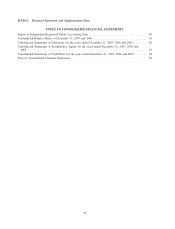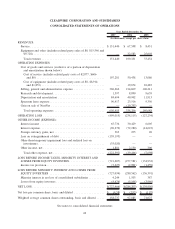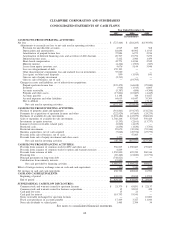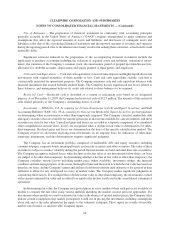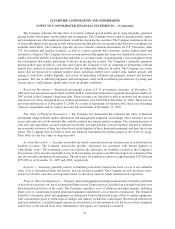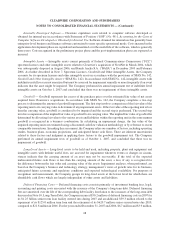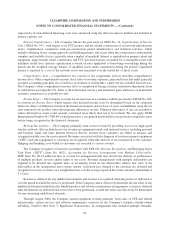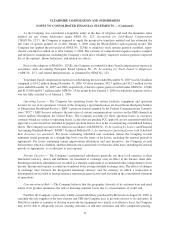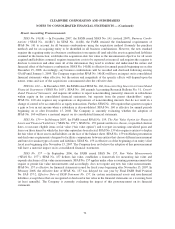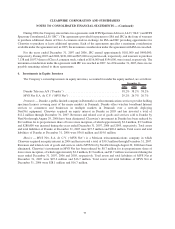Clearwire 2007 Annual Report Download - page 77
Download and view the complete annual report
Please find page 77 of the 2007 Clearwire annual report below. You can navigate through the pages in the report by either clicking on the pages listed below, or by using the keyword search tool below to find specific information within the annual report.respectively of total deferred financing costs were amortized using the effective interest method and included in
interest expense, net.
Interest Capitalization — The Company follows the provisions of SFAS No. 34, Capitalization of Interest
Cost (“SFAS No. 34”), with respect to its FCC licenses and the related construction of its network infrastructure
assets. Capitalization commences with pre-construction period administrative and technical activities, which
includes obtaining leases, zoning approvals and building permits, and ceases when the construction is substantially
complete and available for use (generally when a market is launched). Interest is capitalized on property, plant and
equipment, improvements under construction, and FCC spectrum licenses accounted for as intangible assets with
indefinite useful lives. Interest capitalization is based on rates applicable to borrowings outstanding during the
period and the weighted average balance of qualified assets under construction during the period. Capitalized
interest is reported as a cost of the network assets and amortized over the useful life of those assets.
Comprehensive Loss — Comprehensive loss consists of two components, net loss and other comprehensive
income (loss). Other comprehensive income (loss) refers to revenue, expenses, gains and losses that under generally
accepted accounting principles are recorded as an element of stockholders’ equity but are excluded from net loss.
The Company’s other comprehensive income (loss) is comprised of foreign currency translation adjustments from
its subsidiaries not using the U.S. dollar as their functional currency and unrealized gains and losses on marketable
securities categorized as available-for-sale.
Income Taxes — The Company accounts for income taxes in accordance with the provisions of SFAS No. 109,
Accounting for Income Taxes, which requires that deferred income taxes be determined based on the estimated
future tax effects of differences between the financial statement and tax basis of assets and liabilities using the tax
rates expected to be in effect when the temporary differences reverse. Valuation allowances, if any, are recorded to
reduce deferred tax assets to the amount considered more likely than not to be realized. We also apply FASB
Interpretation Number 48 (“FIN 48”) which prescribes a recognition threshold that a tax position is required to meet
before being recognized in the financial statements.
Revenue Recognition — The Company primarily earns service revenue by providing access to its high-speed
wireless network. Also included in service revenue are equipment rentals and optional services, including personal
and business email and static Internet Protocol. Service revenue from customers are billed in advance and
recognized ratably over the service period. Revenues associated with the shipment of customer premise equipment
(“CPE”) and other equipment to customers are recognized when title and risk of loss transferred to the customer.
Shipping and handling costs billed to customers are recorded to service revenue.
The Company recognizes revenues in accordance with SAB 104, Revenue Recognition, and Emerging Issues
Task Force (“EITF”) Issue No. 00-21, Accounting for Revenue Arrangements with Multiple Deliverables.
EITF Issue No. 00-21 addresses how to account for arrangements that may involve the delivery or performance
of multiple products, services and/or rights to use assets. Revenue arrangements with multiple deliverables are
required to be divided into separate units of accounting based on the deliverables relative fair value if the
deliverables in the arrangement meet certain criteria. Activation fees charged to the customer are deferred and
recognized as service revenues on a straight-line basis over the average expected life of the customer relationship of
3.5 years.
Revenue is deferred for any undelivered elements and revenue is recognized when the product is delivered or
over the period in which the service is performed. If the Company cannot objectively determine the fair value of any
undelivered element included in the bundled product and software maintenance arrangements, revenue is deferred
until all elements are delivered and services have been performed, or until fair value can objectively be determined
for any remaining undelivered elements.
Through August 2006, the Company earned equipment revenue primarily from sales of CPE and related
infrastructure, system services and software maintenance contracts by the Company’s formerly wholly-owned
subsidiary, NextNet (See Note 3, Significant Transactions). In arrangements that included multiple elements,
69
CLEARWIRE CORPORATION AND SUBSIDIARIES
NOTES TO CONSOLIDATED FINANCIAL STATEMENTS — (Continued)


